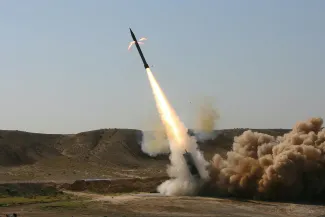Arms Control

Overview
Arms control agreements are a specialized subset of diplomacy that limit developing, testing, producing, deploying, or using certain types of weapons. They can prevent costly and destabilizing arms races. In this hypothetical scenario, the United States needs to decide how to use arms control to reduce the threat posed by one relatively new category of arms: anti-satellite weapons (ASATs).
The Situation
First, cover the fundamentals of this foreign policy tool with the CFR Education resource, What Is Arms Control? Then, put these principles into practice with this simulation's hypothetical decision point below.
Decision Point
Intelligence indicates that Dacan, a longtime U.S. rival, is expanding its arsenal of anti-satellite weapons, which could knock out U.S. communication, navigation, surveillance, weapons guidance, and nuclear early-warning systems. Essentially, an anti-satellite attack could rob the United States of many technological advantages it could otherwise use in a conflict. The United States has more advanced anti-satellite capabilities than Dacan, but both countries are largely unable to defend their satellites. As a result, both have an incentive to move quickly at the earliest sign that the other is considering using their ASATs. This situation could also lead to an arms race over ASAT weapons and satellite defensive systems. Accordingly, the president has convened the National Security Council (NSC) to discuss whether and how to pursue new arms control measures that would limit this threat. NSC members should consider how broad any agreement should be, how to verify any agreement, and whether limiting the danger that ASATs pose is worth constraining U.S capabilities.
NSC members should consider the following policy options:
- Negotiate a treaty on ASATs requiring reductions in arsenal size and limits on testing. This provides the strongest guarantee of a reduced threat from Dacan’s ASATs. It could also preserve the current U.S. advantage. Yet it would still require both the United States and Dacan to compromise their own capabilities. Negotiations would also be difficult as they would need to establish what limitations the treaty should include and how the agreement could be monitored.
- Announce unilateral measures in the hope that Dacan follows suit. These could include disclosures about U.S. ASAT capabilities, policy declarations around using ASATs, or even voluntary force reductions. This could be done quickly and undone if Dacan does not reciprocate. It could also build trust toward a formal agreement. However, this option still requires sacrificing military capability with no verifiable guarantees in return.
- Do not pursue an arms control agreement with Dacan, and focus on developing offensive and defensive capabilities. Researching satellite defenses could mitigate threats, and strengthening U.S. readiness could act as a deterrent or allow for a preemptive strike if necessary. Yet this option does nothing to limit Dacan’s ASAT capabilities and could encourage an arms race that increases the risk of an accident or preemptive strike.
Additional Resources
- U.S.-Russia Nuclear Arms Control Timeline: 1949 – 2021 Council on Foreign Relations
- No-First-Use Policy Explained Union of Concerned Scientists
Need inspiration for how to structure your Mini Simulation?